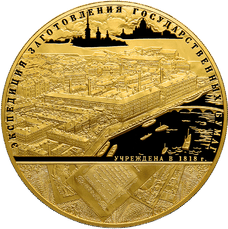Goznak
| Federal State Unitary Enterprise | |
| Industry | currency printing |
| Founded | 1818 |
| Headquarters | 17 Mytnaya St. Moscow, Russia |
| Products | currency, postal stamps, medals, badges, coins, banknotes |
| Owner | Russian government (100%) |
| Parent | Ministry of Finance |
| Website |
www |

Federal State Unitary Enterprise "Goznak" (short for Государственный знак, or State Insignia) is a Unitary enterprise in Russia, 100% government-owned, responsible for the manufacturing of security products, including banknotes, coins, stamps, ID-cards, secure documents, state orders and medals, as well as providing secure IT services. [1] It incorporates 7 factories and 1 R&D institute involved in different stages of the development, research, manufacturing cycle.
Goznak combines paper and printing facilities, which manufacture banknotes, government bonds, checks, letters of credit, savings-bank books (сберегательная книжка), lottery tickets, postage stamps, blanks of passports, birth certificates, marriage licenses, as well as publications of high artistic value and special and high-grade paper. Goznak also controls mints, which manufacture circulation coins, orders, decorations, and commemorative medals. It also manufactures credit cards, banking cards, phone cards. Goznak not only prints Russian money, but also prints banknotes of foreign countries, including Lebanon, Yemen, Guatemala, Rwanda, Angola and others.
History

During the reign of Peter the Great, the Russians established the Saint Petersburg Mint in 1724, which would centralize coinage in Russia and begin to produce different kinds of badges and medals used for decoration.
In 1818, on September 4 (August 21 Old Style) in Saint-Petersburg the Expedition of Storing State Papers (Экспедиция заготовления государственных бумаг) was founded by the Decree of Emperor Alexander I under the authority of the Ministry of Finance; Dmitry Guriev, Minister of Finance, assigned engineer Agustín de Betancourt to design and build the modern, steam-powered currency printshop.
In 1838, a Russian academician Moritz von Jacobi (known as Boris Yakobi in Russia), employed at this Department, used his invention of galvanoplastics to produce printing plates for the first time in printing history. In the 1890s, an employee of the Department Ivan Orlov invented and developed a new printing method called "Orlov's printing" (Орловская печать). Also, he built multicolor printing presses, which would serve as a prototype for modern multicolor printing presses. Orlov's machines were still in use in some countries in the 1970s.
After the October Revolution of 1917, the Department of State Currency Production was reorganized and renamed Goznak (short for Государственный знак, literally State Ensign or Insignia). Although the initial scope of Goznak had been the production of bank notes, the production of coins was added to its field of operation in 1941, when the Leningrad mint was taken over by Goznak.[2] Goznak had its own All-union Research Institute in Moscow. In the 1920s, a Goznak employee and a prominent Soviet sculptor Ivan Shadr created the first samples of the Soviet money. In the 1950s – 1960s, an employee of the Goznak’s Moscow Printing Factory V.A.Oleynik invented an original money counting device, which would be further developed by other workers of the All-union Research Institute. Thus, all of the paper and printing factories and mints of the Goznak were equipped with the counting machines.
After the revolution of 1917 the Saint-Petersburg Mint of Goznak was renamed into the Leningrad Mint. Its original name was returned in the 1990s. The Saint-Petersburg Paper Mill of Goznak was also called the Leningrad Paper Mill during the Soviet period.
In 1997, Perm Printing Factory launched telecards for public telephones. During the first year of the new site more than one million cards were produced. The quality of cards is fully in line with the international standard.
In 1999, the Moscow Mint, for the first time in the history of Russia won the tender for the manufacture of currency for India. In October 1999, they signed an agreement with India for the manufacture of copper-nickel coins two and five rupees.
In 2006 the Association of the State Companies "Goznak" has been transformed into the Federal State Unitary Enterprise "Goznak". Goznak includes 8 branches: 2 Printing Factories, 2 Paper Mills, 2 Mints, Printing House and R&D Institute.
At the beginning of 2006, the Moscow Printing Factory of Goznak started with the personalization of the first ePassport. The personalization center is capable of processing of more than 5 million passports per year. The personalization of the new generation of passports with the electronic data carrier is carried by laser engraving at the Branches of Goznak – at the Main Personalization Center at the Moscow Printing Factory and at the Multifunctional Personalization Center at the Moscow Printing Works.
On March 3, 2008 Goznak has become a strategic enterprise of Russia.
On June 5, 2014 the Russian President Putin signed a decree on the transformation of the company from the status of Federal State Unitary Enterprise to Open Joint Stock Company "Goznak", 100% of which is owned by the federal government.
Structure
"Goznak" incorporates eight branches:
- Moscow Mint
- Perm Printing Factory
- Saint Petersburg Paper Mill
- Saint Petersburg Mint
- Moscow Printing Factory
- Research Institute of Goznak (Moscow)
- Krasnokamsk Paper Mill
- Moscow Printing Works
External links
Notes
- ↑ See Goznak's official website.
- ↑ See Goznak's official website.
| Wikimedia Commons has media related to Goznak. |